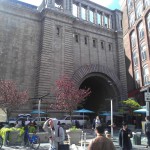1-What is the map’s call number?
The maps call number is BA-2003 FC.
2-What is the map’s title (if available)?
The title of the map is Montague Business Improvement District, 2003.
3-Which collection does the map belong to?
It belongs to Flat Map Collection.
4-When was it made?
It was made in 2003.
Physical description of the map:
5-What size is the map (approximately)?
The size of the map is 1.5 foot by 1 foot.
6-What colors does it use?
It uses grey, orange, green, purple, white and black.
7-What materials were used to make the map?
Laminater Paper was used to make this map.
8-Who made the map?
Identity Map com pay made this map.
Map content:
9-What location does the map depict?
This map depicts Brooklyn Heights, Metro Tech, Boerum Hill and Fort Greene.
10-What details does it include?
It includes street names and major building names.
11-What time period does the map depict? Is this the same as the time when it was made?
The map depicts 21st Century. It is the same.
12-What is familiar to you about the location depicted in the map?
It is located within the area of our college.
Interpretation and Reflection:
13-What is the purpose of the map?
The purpose of the map is to show the buildings in the Business Improvement District (BID).
14-Why did it survive prior to becoming part of the archives at BHS?
It survived because it is relatively new.
15-Why did BHS incorporate it into its collections?
BHS incorporated it into its collections because it has the value regarding the buildings in the Business Improvement District.
16-What is familiar or unfamiliar about the map?
Many buildings are buildings that exist and buildings we know of today.
17-What additional information would you want to better understand the map?
The names of more buildings.
18-Where is City Tech in relation to this map?
It is located on the middle of the map and near the top of the Metro Tech center.




